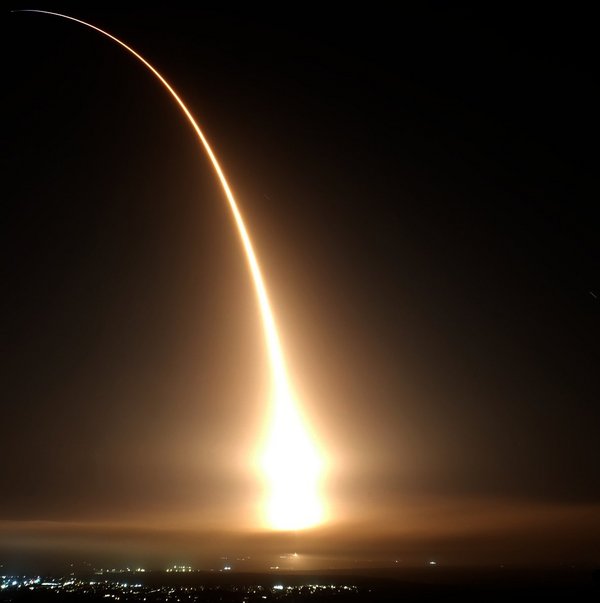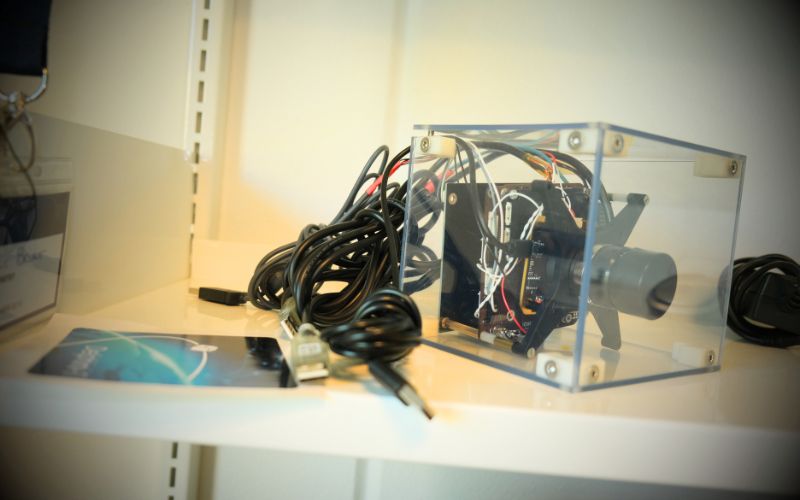A satellite built by AU students in orbit around Earth: Preparations for a new AU space project begin
AU’s space adventure now involves several satellites, almost 50 students, and quite a few sleepless nights. The objective of the space programme is to train graduates for the space sector. A former student member of the project is currently the social media manager for Denmark's only astronaut, Andreas Mogensen.

Translated by Global Denmark
Three, two, one, ignition and lift-off! On 15 April at 08:48 local Danish time, DISCO-1 was launched from the space centre in San José. The team behind the satellite watched the launch from the space centre in California and online back home in Denmark.
The launch had been a long time coming and had been postponed several times – most recently the day before just 28 seconds before lift-off. After the successful launch, the DISCO team could then sit back and wait for the satellite to be released from the spacecraft bus, along with the rest of the payload.
“The satellite wasn’t sent up on its own. It was launched inside another spacecraft along with a lot of other satellites, which aren’t dispatched until the spacecraft bus has been tested and cleared to begin launching the satellites. So the DISCO-1 wasn’t sent into orbit until a month after launch, which is when it could finally be turned on and contacted," says Christoffer Karoff, associate professor at the Department of Physics and Astronomy and head of the DISCO project.
He welcomes us into the project’s premises, aptly named DISCOteket (the DISCOtheque).

ABOUT THE DISCO PROGRAMME
- The DISCO programme is a collaboration between AU, the SDU, AAU, the IT University of Copenhagen and the European Space Education Resource Office (ESERO).
- DISCO-1 was sent into space on 15 April as the first of two.
- DISCO-2, like DISCO-1, was built in collaboration with the Aalborgensian company Space Inventor. The contract between AU and Space Inventor was signed on 10 January.
- DISCO-1 is a technological demonstration that includes a number of student projects, while DISCO-2's primary function will be to take pictures of Greenland from space.
- The students behind the DISCO programme keep a logbook on the blog discosat.dk, where you can read more about the process behind developing and launching the satellites.
- Prior to DISCO-1, AU was able to send the Delphini-1 satellite into space in 2018. It was in orbit for two years and its job, like the job of DISCO-2, was to take photos from outer space.
- You can read more about the DISCO programme on AU’s website.
Graduates for the space sector
The team behind the DISCO programme consists of almost 50 students from Aarhus University, Aalborg University, the IT University of Copenhagen and ESERO. The aim of the programme is to train more Danish students to design, launch and work with satellites and to develop a skilled workforce for the space sector. Additionally, the programme also aims at ensuring a strong collaboration between Denmark and the larger international space agencies such as NASA and the European Space Agency ESA.
“The programme can help students who want a career within the space sector. In fact, a student from our last project, Delphini, is currently the social media manager for Andreas Mogensen, so we have quite close contact with the sector," says Christoffer Karoff.
The first satellite, DISCO-1, was launched as a so-called technological demonstration.
"We must demonstrate that we have mastered the technology necessary to send more satellites into space. Even though both Aarhus University and the other partner universities have launched satellites previously, there are some technologies in DISCO-1 that we need to test before we can launch other projects," explains Christoffer Karoff.
DISCO-1 is therefore the forerunner of AU’s upcoming satellite project DISCO-2.
One of the students on the project is its PR manager Jacob Bay Thomsen. He will complete his Master's degree in astronomy this coming winter.
"The students on the project will primarily use DISCO-1 to learn about how radio communication with a satellite works. And then we'll test whether we're good enough to make DISCO-2 more advanced," he says.

Four days of radio silence
One by one, the spacecraft bus launched its payload of satellites, including DISCO-1. However, DISCO-1 didn’t make a peep once it had been sent into orbit. For four days both students and teaching staff on the project had to run through every possible error they could think of.
"There’s a significant risk of something going wrong during the launch, so we were naturally worried that something had happened to the satellite’s hardware. Things like that can happen when you’re launching something into space," says Christoffer Karoff, and stresses that the team did not at any point give up hope for DISCO-1.
Finally contact!
As it turned out, the satellite did not respond because the recipient's amplifier had been switched off, and because the DISCO-1 team had been given the coordinates for a different satellite, which didn’t respond because it was tuned to another frequency.
"Sending radio signals at a certain frequency to ask ‘Are you there?’ is called pinging. If the satellite receives the signal, it sends a "ping" in return, as if to say ‘Yes, I’m here.’,” explains Jacob Bay Thomsen.
The students worked day and night to get in touch with the satellite. On 23 May at 11:27, the stars aligned and the students from Aarhus University finally received a signal from DISCO-1.
In rapid orbit around the Earth
After four sleepless nights, the students could finally breath a sigh of relief. The late nights had been necessary to establish contact with the satellite because DISCO-1 must be above the Katrinebjerg ground station’s horizon in order for the antennas to receive any signals.
"The best time to get in touch with the satellite fluctuates a bit. At the beginning it was usually at night," explains Christoffer Karoff.
When the satellite passes through the skies above the ground station, the antenna on top of one of Katrinebjerg’s roofs must be pointing directly at it to establish contact. And this was particularly challenging in the beginning when the team didn’t have the right coordinates.
"The satellite is only within range for ten minutes at a time. You have to know where it is, rather than having to point the antenna in all sorts of random directions to find it. Once the satellite has passed by, it’ll be another two to ten hours before we can establish contact again because the satellite is in what’s called a polar orbit. It orbits the globe from pole to pole, while the Earth revolves around itself, so how long it takes the satellite to come back into range varies,” explains Jacob Bay Thomsen.
The lightning fast satellite flies at a speed of ten kilometres per second, so when its in its shortest orbit, it can complete its route between the poles in just one hour and 15 seconds.
"Yeah, it could probably fly from here to Aalborg in fifteen seconds," says Christoffer Karoff.
DISCO-2
Now that DISCO-1 is safely orbiting the Earth, the planning stage for DISCO-2 can swing into high gear. A contract with the Aalborgensian company Space Inventor, who helped build DISCO-1, was already signed back in January and the recruitment process to find students for the new space project is well underway.

DISCO-1 garnered a lot of attention when it was launched from California and, according to Christoffer Karoff, the reverberations of that attention could clearly be felt when it came to recruiting students for DISCO-2. No less than 70 students interested in joining the project showed up on the recruitment day. With only about 30 spots available on the team, the interested students will therefore be selected on the basis of their applications.
"In the beginning, my hope was to attract about 20-30 people. I never dreamed to see as many people as I did that day. This is something they’d be doing in their free time, so I was surprised that there’s actually 70 students at Aarhus University who’d want to spend their spare time on the project,” says Christoffer Karoff.
One of DISCO-2’s tasks will be to take photos of Greenland, which can then be used for research at the collaborating universities. At the moment, Danish universities need to buy images from NASA, which is both costly and a hassle.
"With DISCO-2 in orbit, researchers can ask us to take pictures of specific areas instead of always having to buy data from other places that may not even have images of the area they need," says Jacob Bay Thomsen.
AU has previously had a satellite designed for this exact same purpose: Delphini-1, which was launched at the beginning of 2018. But a satellite doesn’t live forever.
"Delphini was the first AU satellite that could take pictures from space But since it, according to plan, burned up after two years in orbit, we haven't had that ability," says Christoffer Karoff.

When the space adventure comes to an end
Just like Delphini, both DISCO-1 and DISCO-2 will end their days by burning up in the atmosphere.
"DISCO-1 is a so-called CubeSat that measures 10x10x10 centimetres. Satellites of this size orbit the Earth at a height that means they eventually fall back down through the atmosphere due to air resistance," explains Christoffer Karoff.
When you apply to send a satellite into space, you have to document that the satellite will fall out of orbit no more than 25 years after it is taken out of use.
Christoffer Karoff expects both DISCO-1 and DISCO-2 to be in orbit for up to seven years before air resistance gets the better of them. However, it is far from certain that they will be able to stay in touch with the satellites for that long.
"The goal is for them to last for 1-2 years," explains Christoffer Karoff.
And even when the adventure ends for DISCO-1 and DISCO-2, the DISCOtheque will keep the party going. AU has more space adventures in store with both DISCO-3 and DISCO-4.

